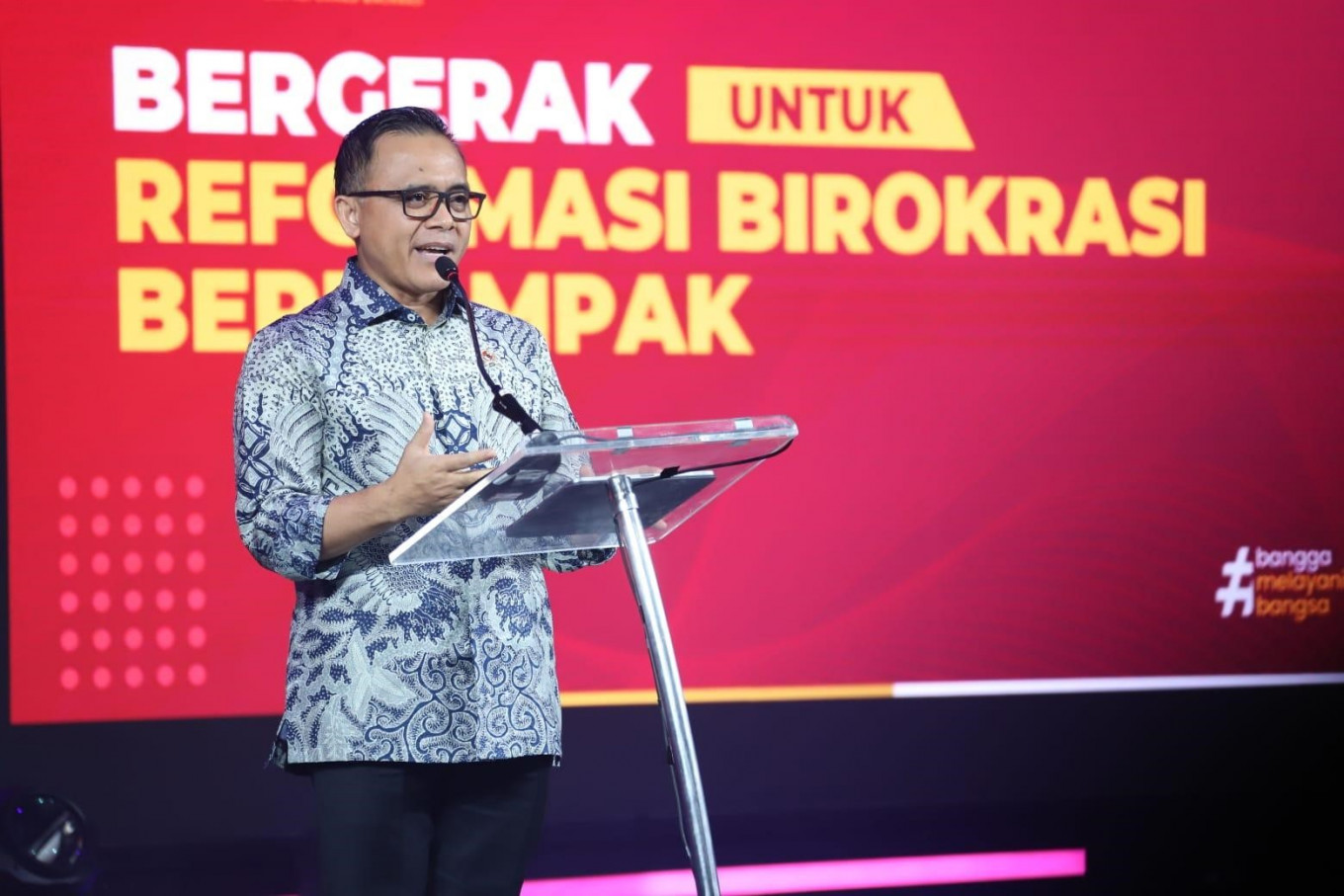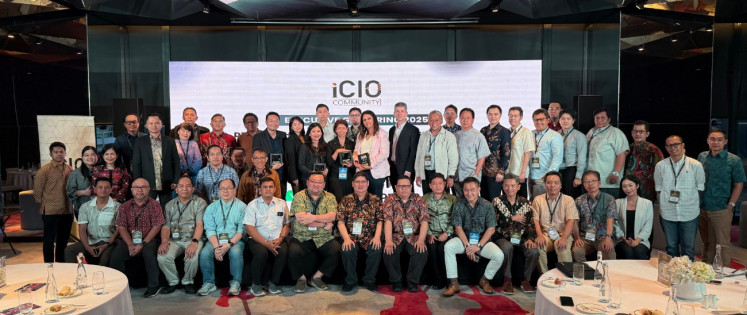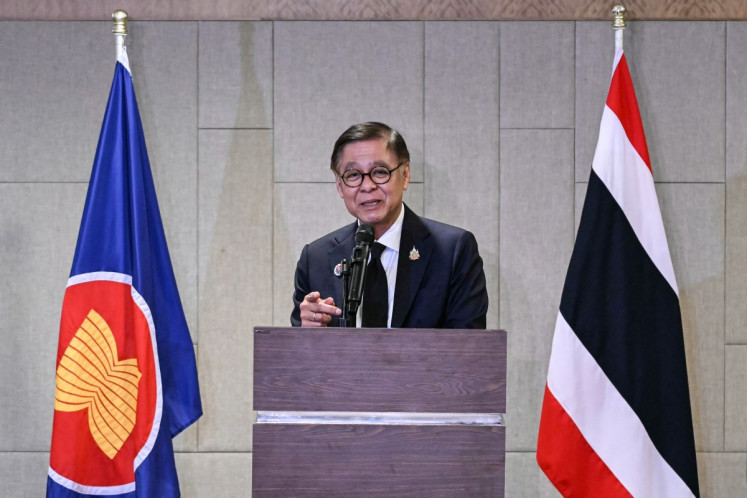Popular Reads
Top Results
Can't find what you're looking for?
View all search resultsPopular Reads
Top Results
Can't find what you're looking for?
View all search resultsBureaucratic reform minister outlines ministry’s achievements in past decade
Change text size
Gift Premium Articles
to Anyone
A
dministrative and Bureaucratic Reform (PAN-RB) Minister Abdullah Azwar Anas has highlighted the ministry’s achievements over the past 10 years, noting a trend of improvement in the bureaucratic reform index. Its impact has been seen in poverty alleviation efforts, increased investment and use of domestic products, as well as the strengthening of the government’s digital ecosystem.
"This shows the consistency of the government's efforts in improving its governance, which is increasingly good at achieving a clean, accountable, effective and efficient bureaucracy that is able to provide excellent public services to the community," he said on Tuesday.
In the last five years, Indonesia's bureaucratic reform has contributed significantly to various achievements on a global scale that have brought the archipelago to a fairly competitive position with other countries.
Based on the Worldwide Governance Indicators, Indonesia has managed to rise from 99th position in 2017 to 73rd in 2022 for government effectiveness, as well as rising from 94th to 87th for regulatory quality.
In addition, Indonesia's ranking in the Global Innovation Index rose from 85th in 2019 to 54th in 2024, while its Electronic Government Development Index (EGDI) ranking rose from 107th in 2017 to 64th in 2024. Furthermore, Indonesia's ranking in the business sector perspective is also no less competitive than other countries.
The implementation of bureaucratic reform has shown good improvement overall, with the average trend of the Bureaucratic Reform Index showing an increase in ministries and institutions, as well as provinces, regencies and cities.
In 2014, the average Bureaucratic Reform Index in the ministries/institutions category was 52.31, rising to 76.81 in 2023. In provinces, the figure showed an improvement from 41.62 to 69.71, while the index for districts/cities rose from 55.97 to 59.32 in the same period.
During his term, Anas accelerated the implementation of bureaucratic reform by focusing on thematic bureaucratic reform targeting four main focuses; poverty alleviation; increasing investment; digitalization of government administration; and acceleration of the President's actual priorities, which include controlling inflation and increasing the use of domestic products (PDN).
As a result, regions that implement significant thematic bureaucratic reform recorded an average poverty rate of 5.16 percent, far below the national average. Thematic bureaucratic reform also contributed 63 percent of the total increase in investment in Indonesia, as well as increasing PDN realization by 14 percent from the previous year to 90.34 percent.
"All of these thematic areas are supported by the electronic government system (SPBE) architecture to maintain the integration and harmony of steps in implementing digitization," he said.
Over the past 10 years, more and more government agencies have implemented the “money follows the program, the program follows results” concept. The implementation of the Government Agency Performance Accountability System (SAKIP) is able to prevent potential waste of the state and regional budget (APBN/APBD) and prevent the use of funds in a way that is off-target.
Efforts to accelerate digital transformation and integration of government digital services have been carried out by Anas and supported by ministries and institutions through the formation of a Government Technology (GovTech) called INA DIGITAL. President Joko “Jokowi” Widodo inaugurated INA DIGITAL on May 27 as the coordinator of the government's digital service ecosystem that integrates thousands of applications.
As a follow-up, the PAN-RB Ministry, together with the State-Owned Enterprises (SOEs) Ministry, the Communications and Information Ministry, Peruri and INA Digital, has released the initial stage of the national portal and integrated digital identity in the form of INApas, INAku and INAgov. This integration is also a strategic step to accelerate Indonesia's digital transformation.
Anas noted that the achievement of the National SPBE index had continued to increase, rising from 1.98 in 2018 to 2.79 in 2023.
"This has exceeded the national target of 2.6," he explained.
At the international level, the UN E-Government Development Index (EGDI) also showed an increase in ranking from 107 in 2018 to 64 in 2024, placing Indonesia in the very high EGDI category for the first time. In addition, its Gov Tech Maturity Index rose from B to A (2022).
The government has also simplified the bureaucracy during President Jokowi's leadership. More than 55,000 organizational units have been simplified, while 43,000 positions in ministries and institutions have been equalized to functional positions.
In addition, the PAN-RB Ministry has also simplified the classification of implementing positions from 3,414 classifications to three job classifications. This arrangement is expected to support an increasingly effective and agile bureaucracy in line with the development of digital work mechanisms and business processes.
In order to improve the ease of service for the community, the government has provided as many as 280 Public Service Malls (MPP), both physical and digital, throughout Indonesia.
"Now, the number of MPPs is increasing outside Java, so that excellent public services are not only centered in Java. This means that the Indonesia-centric concept is not only related to physical infrastructure, but also to public services," said Anas.
During Anas' leadership, a transformation of civil servant management has been carried out through an amendment to the State Civil Apparatus (ASN) Law, namely Law No. 20/2023. The draft government regulation (PP) on ASN management, as a derivative of the law, will soon be completed. In this sector, the government has carried out various transformations, including procurement, human resources for certain organizations, government employees with work agreements (PPPK), competency development, rank status, employee leave, dismissal and digitization of ASN management.
The government has also carried out a transformation in the periodization of civil servant promotion, which benefits civil servants as it eliminates long delays to promotions.
"Initially there were only two periods in one year, now there are six submission periods," said Anas.
Related to organizational simplification, the government has integrated non-structural institutions (LNS).
"In the past ten years, LNS has been dissolved several times. From 2019 to 2024 alone, as many as 38 LNS have been dissolved."
In implementing the evaluation of bureaucratic reform, the PAN-RB Ministry eliminated the independent assessment (PMPRB), which has so far taken up significant resources, necessitated the answer of 259 question components and uploaded thousands of documents. The bureaucratic reform evaluation in comparison only calculates 26 impact indicators, including poverty, investment, digitalization, domestic product spending and inflation control.










